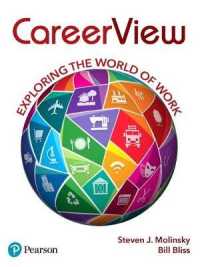- ホーム
- > 洋書
- > 英文書
- > Nature / Ecology
Full Description
The legacies of a century of fossil-fuel based development and
overconsumption, of treating the environment as a waste sink for industry
and agriculture, have left devastating impacts on the earth's air, water and
land, and these are directly implicated in Climate Change. In response, a
number of global institutions and nations, including the European Union
and China, have committed themselves to the development of a 'circular
economy'. This will require a transformation of today's 'linear economy' of
'make, use and dispose' as the market dictates, into a Circular Economy.
The aim of the Circular Economy is to decouple economic growth from
resource and energy use through iterative, systemic social, economic and
technological reform. This book presents new theoretical and practical
insights into this concept, based on case studies from both the developing
and developed world, with an emphasis on economic and material
transformation, design for reuse and waste reduction, industrial 'symbiosis'
(the planned circulation of resources and energy within an industrial setting),
and social innovation and entrepreneurship.
Four central themes emerge through the essays presented here: the
importance of 'restorative design' in transforming resource flows through
both production and consumption, the value of understanding and
enumerating wastes in more detail to enable their reuse, the central role
of advancing technology and applied science to further this transformation
of materials for reuse, and finally, a reconfiguration of design, consumption
and retail, so that the present 'linear' economy of 'make, use and trash' can
be replaced with a more 'circular' model.
Contents
Preface: Professor Li'an Hou - Academic, Chinese Academy of Engineering Introduction. Robert Crocker, Christopher Saint, Guanyi Chen, and Yindong Tong
Part 1: History, Theory and Experience
1. From 'Spaceship Earth' to the Circular Economy: The Problem of Consumption; Robert Crocker
2. Can Economics assist the Transition to the Circular Economy?; Martin Shanahan
3. China's Policies for promoting a Circular Economy: Past-Decade Experiences, Future Plans and Success Stories; Xu Zhao
4. Biosolids: The Growing Potential for Use; Norman Goh, Michael P Short, Nanthi S Bolan, and Christopher P Saint
Part 2: Consumption, Design and Behaviour
5. Considering 'Waste Value' in the Circular Economy; Helene Cherrier, Meltme Türe, and Nil Özçağlar-Toulouse
6. Circular by design: A Model for engaging Fashion / Textile SMEs with Strategies for Designed Reuse; Jen Ballie and Mel Woods
7. The ByeBuy! Shop: Testing Shopping Scapes in a Circular Economy; Kirsty Máté
8. What role for Social Enterprises in the Circular Economy?; Ruth Lane and Wayne Gumley
9. Developing Measures for the Waste Management Hierarchy: A South Australian Case Study; Anne Sharp, Lara Stocchi, Vaughan Levitzke and Marcia Kreinhold
Part 3: Waste and Resource Recovery
10. Australian Regional Waste Footprints; Jacob Fry, Manfred Lenzen, Damien Giurco, and Stefan Pauliuk
11. Renewing Materials: Implementing 3D printing and Distributed Recycling in Samoa; Lionel Taito-Matamua, Simon Fraser, and Jeongbin Ok
12. The Current State of Scrap Utilization by Thai SMEs; Singh Intrachooto
13. Unmaking Waste in Construction in the EU and Asian Circular Economy: A Formal Institution Approach; Rita Yi Man Li, Li Meng, Tat Ho Leung, Jian Zuo, and Yuan Wang
14. Municipal Solid Waste Properties in China: A Comparison Study between Tibet, Beijing and Guangzhou; Wenchao Ma, Lina He, Zeng Dan, Guanyi Chen and Xuebin Lu
Part 4: Technology and Systems Innovation
15. Green Manufacturing - From Waste to Value Added Materials; Samane Maroufi, Claudia Echeverria, Farshid Pahlevani and Veena Sahajwalla
16. Towards an Agile Circular Economy for the Building Industry; Tim Mcginley
17. Research on the Sustainable Water Recycling System at Tianjin University's New Campus; Sen Peng, Huiping Cui, and Min Ji
18. Re-Valuing Construction Materials and Components through Design for Disassembly; Philip Crowther
19. Construction and the Circular Economy: Smart and Industrialised Prefabrication; Abbas Elmualim, Sherif Mostafa, Nicholas Chileshe, Rameez Rameezdeen, and Kerry London
Afterword: Vaughan Levitzke






